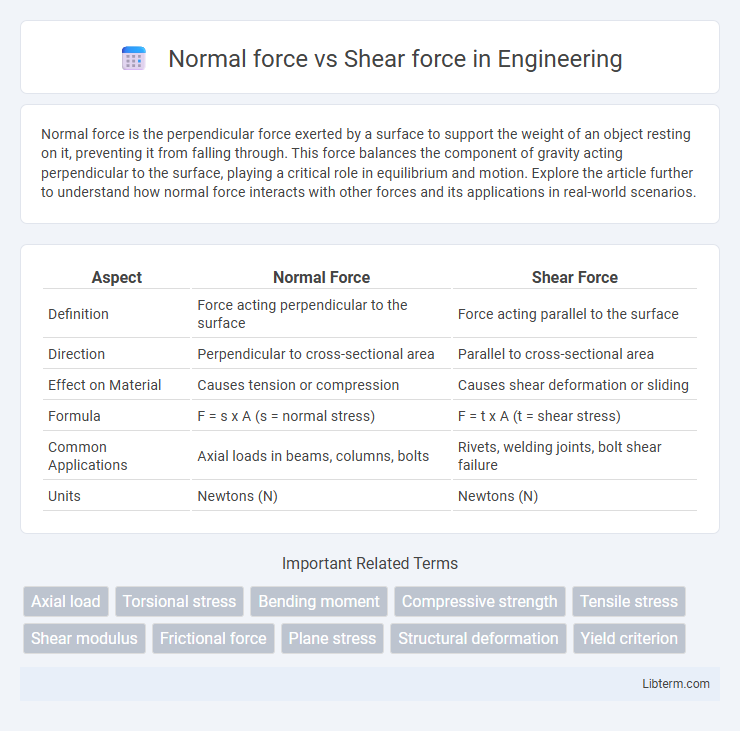Normal force is the perpendicular force exerted by a surface to support the weight of an object resting on it, preventing it from falling through. This force balances the component of gravity acting perpendicular to the surface, playing a critical role in equilibrium and motion. Explore the article further to understand how normal force interacts with other forces and its applications in real-world scenarios.
Table of Comparison
| Aspect | Normal Force | Shear Force |
|---|---|---|
| Definition | Force acting perpendicular to the surface | Force acting parallel to the surface |
| Direction | Perpendicular to cross-sectional area | Parallel to cross-sectional area |
| Effect on Material | Causes tension or compression | Causes shear deformation or sliding |
| Formula | F = s x A (s = normal stress) | F = t x A (t = shear stress) |
| Common Applications | Axial loads in beams, columns, bolts | Rivets, welding joints, bolt shear failure |
| Units | Newtons (N) | Newtons (N) |
Introduction to Normal Force and Shear Force
Normal force is the perpendicular contact force exerted by a surface on an object, preventing it from penetrating or falling through the surface. Shear force acts parallel to the surface, causing deformation by sliding layers of material relative to each other. Understanding the distinction between normal and shear forces is essential in structural analysis and mechanical engineering to evaluate stress distribution and material behavior under different loading conditions.
Definition of Normal Force
The normal force is the perpendicular contact force exerted by a surface on an object, acting orthogonally to the interface between the two. It counteracts gravitational pull and prevents objects from penetrating surfaces, playing a crucial role in equilibrium and structural stability. Unlike shear force, which acts parallel to the surface causing deformation, the normal force maintains the object's position by balancing components of external forces perpendicular to the contact plane.
Definition of Shear Force
Shear force is defined as the internal force that acts parallel to the surface of a material, causing deformation by sliding one layer over another. Unlike normal force, which acts perpendicular to the surface, shear force resists forces that attempt to cause angular distortion or shear strain within structural elements. Understanding shear force is critical in analyzing beams, shafts, and other components subjected to transverse loads.
Key Differences Between Normal and Shear Forces
Normal force acts perpendicular to the surface, causing compression or tension within a material, while shear force acts parallel to the surface, resulting in deformation by sliding layers. The magnitude of normal force directly influences axial stress, whereas shear force determines shear stress in structural elements. Understanding these distinctions is crucial for analyzing stress distribution and failure modes in engineering applications.
Mathematical Representation of Normal and Shear Forces
Normal force is mathematically represented as \( F_n = \sigma \cdot A \), where \( \sigma \) is the normal stress and \( A \) is the cross-sectional area perpendicular to the force. Shear force is expressed as \( F_s = \tau \cdot A \), with \( \tau \) representing the shear stress acting parallel to the surface area \( A \). Both forces are crucial in structural analysis, determining deformation and failure modes in engineering materials.
Real-world Examples of Normal Force
Normal force acts perpendicular to contact surfaces, supporting objects against gravity, such as a book resting on a table where the table exerts an upward normal force equal to the book's weight. In construction, the normal force is critical in beams supporting loads vertically, counteracting the downward force of materials stacked above. When a person stands on the ground, the ground provides a normal force equal and opposite to the person's weight, preventing them from sinking.
Real-world Examples of Shear Force
Shear force is commonly observed in real-world applications such as the cutting action of scissors, where the blades apply opposing forces that slide past each other to sever material. Bridges and beams experience shear forces from loads that cause one part of the structure to move parallel but opposite to the adjacent part, critical in structural engineering to prevent failure. In manufacturing, shear forces play a crucial role during metal cutting and machining processes, where precise control of shear stress ensures material is shaped without compromising integrity.
Effects of Normal and Shear Forces on Materials
Normal forces generate perpendicular stress that primarily causes compression or tension in materials, influencing their deformation and potential failure modes such as buckling or fracture. Shear forces induce parallel stress that results in sliding layers within the material, often leading to shear strain, yielding, or delamination. The interplay between normal and shear forces determines the overall structural integrity and fracture behavior in materials under complex loading conditions.
Applications in Engineering and Construction
Normal force plays a critical role in structural engineering by supporting loads perpendicular to surfaces, ensuring stability in columns, beams, and foundations. Shear force is essential for analyzing forces parallel to surfaces, preventing sliding failures in fasteners, beams, and masonry walls. Proper evaluation of both forces enhances the safety and durability of bridges, buildings, and mechanical components under varying load conditions.
Summary: Comparing Normal vs Shear Forces
Normal force acts perpendicular to a surface, supporting objects against gravity or other perpendicular loads, while shear force acts parallel, resisting sliding or deformation along the surface. Normal forces are crucial in structures for maintaining stability and preventing crushing, whereas shear forces influence material failure modes like shear stress or fractures. Understanding the distinct roles of normal and shear forces helps engineers design safe, efficient systems by addressing both perpendicular support and parallel stress resistance.
Normal force Infographic

 libterm.com
libterm.com